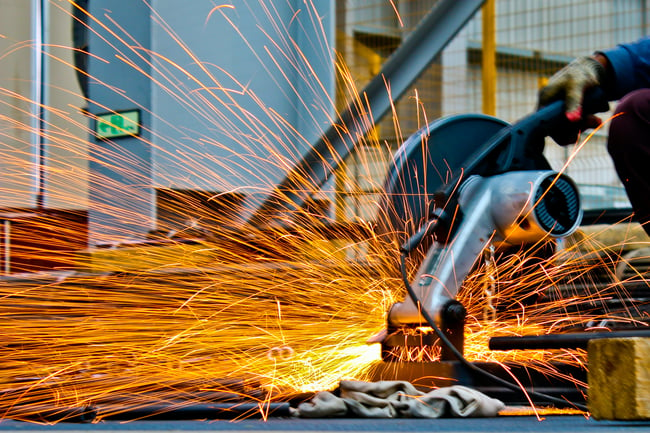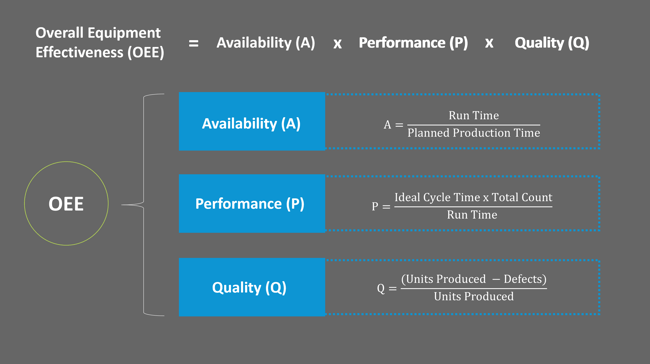Overall Equipment Effectiveness (OEE) is a measure of how well a manufacturing operation is utilized compared to its full potential. In other words, it is a way to identify the areas of production time that are actually efficient and productive - which are key areas for any manufacturing operation.

The OEE value is represented as a percentage. A score of 100% means that you are utilizing your resources to their full extent - you are producing quality products, quickly, with little to no machine downtime.
Anything lower than 100% is considered an opportunity for improvement, which is one of the main goals of total production maintenance. Calculating the Overall Equipment Effectiveness will enable your production to have a clear insight into areas of your manufacturing operation that can be improved. OEE can easily identify losses, inefficiencies, and progress while you work to improve productivity within the organization.
Functions and Calculation of Overall Equipment Effectiveness

The formula to calculate Overall Equipment Effectiveness is as follows:
OEE = Availability (A) x Performance (P) x Quality (Q)
The three components - availability, performance, and quality - represent areas that suffer the biggest losses. Poor product quality with many defects, a slow performance rate, and lots of stopping and starting makes for an unproductive system. Each component of the equation has its own definition and calculation as well:
- Availability (A)
- Availability = Run Time / Planned Production Time
- This component takes into account all of the events that prevent production from running. This can include planned stops such as changeovers and setup time, or unplanned stops such as machine breakdowns.
- Performance (P)
- Performance (P) = (Ideal Cycle Time x Total Count) / Run Time
- This component takes into account all of the events that cause manufacturing to have a slower run rate than the maximum possible run rate.
- Quality (Q)
- Quality (Q) = (Units Produced - Defects) / Units Produced
- This component accounts for all of the manufactured goods that don't meet the quality standards desired or are in need of a rework.
Improving Overall Equipment Effectiveness
So you've calculated your Overall Equipment Effectiveness and you're getting a value lower than 100%. What is causing this? For each component, there are a few factors that could be worsening the effectiveness of your resources.
Availability
- Setup/Changeover: When your production schedule is not optimized, you may incur large amounts of setup or changeover time when changing from one product to another. This issue can be fixed by using an advanced planning and scheduling software that can help you automatically optimize your production schedule to minimize the sequence-dependent setup time.
- Machine Breakdown: Unexpected stops in production time are often caused by machine breakdowns or unplanned maintenance work. One way to improve OEE is to evaluate whether your machines need to be replaced, especially if they stop functioning often. Scheduling periodic maintenance work can help avoid major breakdowns.
Performance
- Reduced Speed: Machines that are worn out, dirty, or have missed too many maintenance checks are likely to run at a slower rate than brand new or unkept machines. In addition, poorly trained or inexperienced employees will also work slower than intended. This component can be improved by performing the regulatory maintenance required for the machines (which will also help with the Availability component) and invest in proper training for your employees.
- Minor Stops: There are many reasons why a machine would need to be stopped for a brief period of time. These minor stops are the equivalent of needing to stop your printer to fix a paper jam or change the ink cartridge. None of these require substantial maintenance but nevertheless affect the maximum run rate of the printer.
Quality
- Defects: This is the main loss within the Quality component of OEE. Defects can include items that are scraps or those that can be reworked. Many things can cause defects, such as improper handling of the equipment or mistakes in setting up the machines. Standard production procedures can help reduce the number of defects that are produced.
- Low Yield: Low Quality numbers can also arise from low total units produced. This occurs when machines are not producing as many items as they should due to high changeover times or if they produce a lot of waste upon startup.
Calculating Overall Equipment Effectiveness can enable you to have a thorough insight into your operations and machines. This will allow you to identify areas that are causing you to be inefficient and are in need of improvement. Once OEE is calculated, softwares like advanced planning and scheduling (APS) systems can help you optimize your production schedule to minimize downtime and increase output.
Advanced Planning and Scheduling (APS) Software
Advanced Planning and Scheduling Softwares have become a must for modern-day manufacturing operations as customer demand for increased product assortment, fast delivery, and downward cost pressures become prevalent. These systems help planners save time while providing greater agility in updating ever-changing priorities, production schedules, and inventory plans. APS Systems can be quickly integrated with an ERP/MRP software to fill the gaps where these systems lack planning and scheduling flexibility, accuracy, and efficiency.
With PlanetTogether APS you can:
- Create optimized schedules that balance production efficiency and delivery performance
- Maximize throughput on bottleneck resources to increase revenue
- Synchronize supply with demand to reduce inventories
- Provide company-wide visibility to resource capacity
- Enable scenario data-driven decision making
The implementation of an Advanced Planning and Scheduling (APS) Software will take your manufacturing operations to the next level of production efficiency by taking advantage of the operational data you already possess in your ERP system. APS is a step in the right direction of efficiency and lean manufacturing production enhancement. Try out a free trial or demo!
Related Lean Manufacturing Video
APS Resources